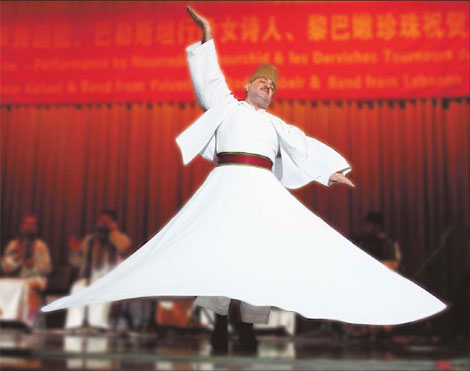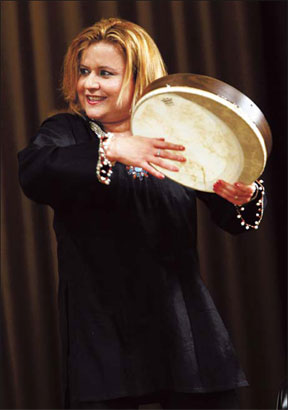Life and Leisure
Thrilling arts, harmonious Asia
By Mu Qian (China Daily)
Updated: 2010-11-16 07:56
 |
Large Medium Small |

Syrian performers stage the whirling dervish dance of Islam's Sufi tradition for the first time in China. Mu Qian / China Daily
Charming Asia is a cultural feast rolled out to coincide with the Asian Games and Asian Para Games. Mu Qian reports
At the Lingnan Convention Hall of Guangzhou, Syrian Sufi musician Nourredine Khourchid and his "whirling dervishes" group share the same stage with Christian singer Ghada Shbeir from Lebanon.
On the same night, at the Huanghuagang Theater of Guangzhou, the Royal Ballet of Cambodia performs a dance drama based on a Khmer mythical love story between the half-bird, half-woman Monorea and prince Preah Sothun.
Both performances are from Charming Asia, a program of Asian music and dance dedicated to the ongoing 16th Asiad. The program presents performing arts from various Asian countries that Chinese audiences will have rarely seen before.
"I'm honored to be here. I think this program shows both the unity and variety of Asian arts. Sharing the stage with artists from so many different countries is an amazing experience for me," says Reem Kelani, a Palestinian singer who performed at the first concert of the series on Nov 8.
It is the first time the whirling dervish dance of Islam's Sufi tradition has been staged in China, but cultural differences were not a problem for Khourchid and his musicians and dancers.
Originally a religious ritual, the dance of the whirling dervishes involves continuous whirling and is said to represent a mystical journey of man's spiritual ascent through love to "perfection".
Although the audience seemed a little dazed at first, the dancing and mesmerizing music elicited storms of applause after each song.
|
Palestinian singer Reem Kelani performs at Charming Asia. Zou Zhongpin / China Daily |
"We may have different cultural backgrounds, but we share the same love for life, which I think is the reason why our performance touches the Chinese audience," Khourchid says. "The Asian Games have provided a great platform for culture and arts."
This is the second tour for the Royal Ballet of Cambodia, the first being 51 years ago.
"Each country has its own traditions. What we are presenting here is a dance style of eight centuries' history," says Norodom Buppha Devi, princess of Cambodia and director of the troupe.
"You can see that many of our dancers look exactly like the figures at Angkor Wat, except that we move."
Having toured China in 1959 as a principal dancer with the Royal Ballet of Cambodia, Buppha Devi says instability at home was the reason her troupe had not toured China for such a long time, but they were glad to be back for the Asian Games.
The Charming Asia program will run through the Asian Games, with performances by such groups as Huun Huur Tu from Tuva, Egschiglen from Mongolia, Mekar Bhuana Conservatory Group from Indonesia, Htay Htay Maw from Myanmar, Rustavi Ensemble from Georgia, Djivan Gasparyan from Armenia, Eastmania Ensemble from United Arab Emirates, and Ensemble Shanbehzadeh from Iran.
"We never had a chance to appreciate such a variety of performances in Guangzhou in the past. I'm really excited about these art programs of the Asian Games and I want to see every one of them," says Ning Biaoxue, a 30-year-old Guangzhou resident, after watching one of the concerts and studying the program.
Ning says people in Guangzhou tend to be rather conservative in terms of culture and usually focus on arts of Cantonese origin. A fan of world music, he sometimes has to travel to Hong Kong and Shenzhen to see concerts because they do not take place in Guangzhou.
"Guangzhou is one of the biggest and most developed cities in China, yet it lacks an art scene that is proportional to its status," Ning says. "I hope there will continue to be performances of various styles in Guangzhou after the Asian Games."
Charming Asia is a part of the big cultural feast that the Guangzhou government is sponsoring during the Asian Games and Asian Para Games period.
From Nov 8 to Dec 19, 317 performances of 38 programs will be held in the city, involving more than 2,000 artists from 20 countries and regions, performed to an estimated 200,000 plus spectators.
There will also be 79 exhibitions held during the period. Most tickets to these performances and exhibitions are being given out to residents of Guangzhou communities free of charge.
In terms of scale and number, the Asian Games' art events have surpassed that of any past arts festivals held in the city, including the ninth China Arts Festival earlier in 2010, which had 111 performances.
"Nowadays large-scale events have become the best platforms for culture. Just as the World Expo is not only about novel technology, the Asian Games are not only about sports," says Lin Jian, curator of Charming Asia and director of World Music Shanghai, the only festival of world music in China.
"For Chinese people, such events are good starting points to get to know more about other cultures."
Lin believes that now is a good time to promote world music to Chinese audiences, as China's economic development has allowed its people to expand their horizons.
"Chinese people have learned from the 'advanced' culture of the West for several decades since reform and opening-up. Now that many Chinese people have traveled to Western countries and know about Western culture, it's time that we pay more attention to cultures of other parts of the world."
